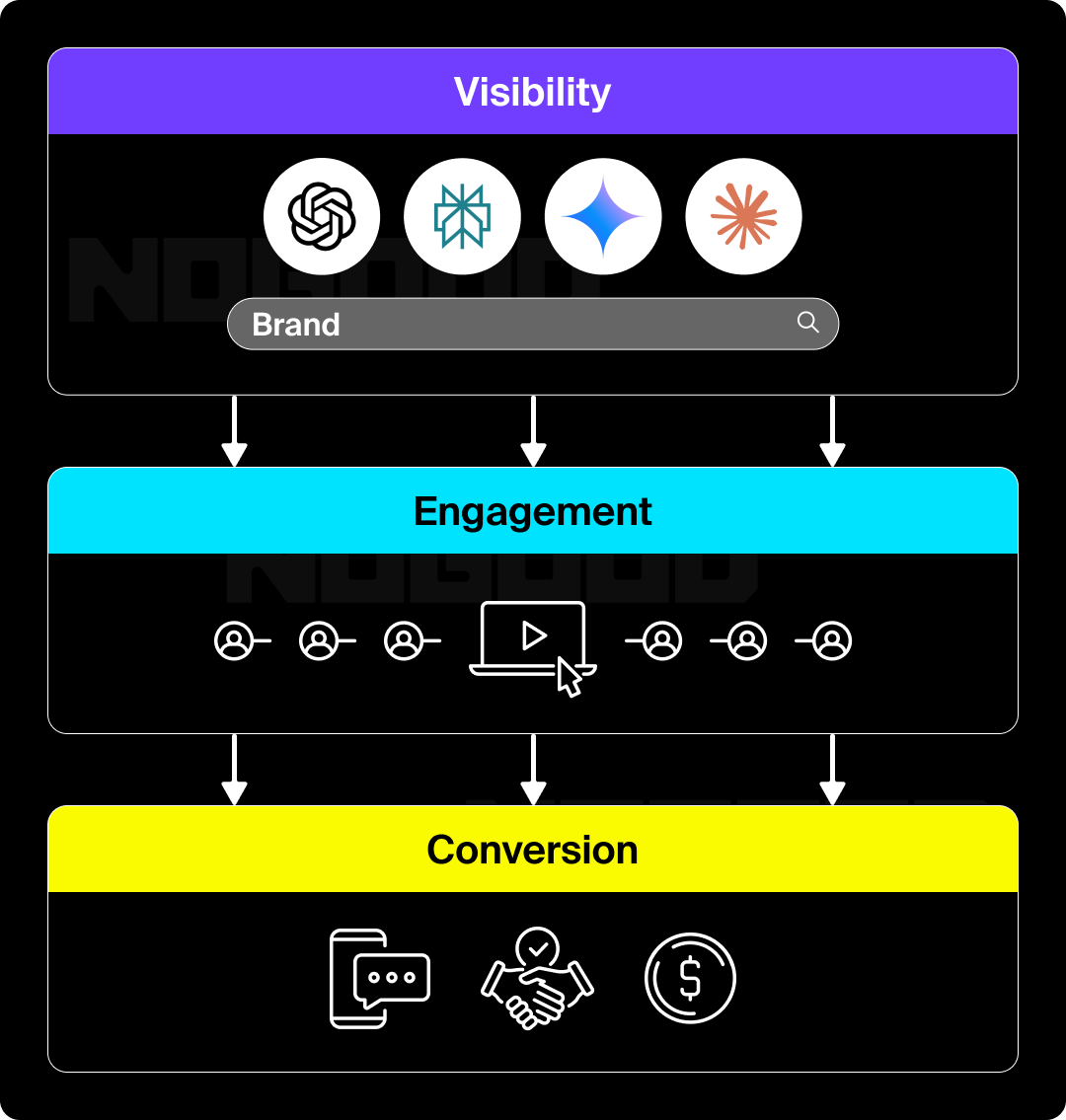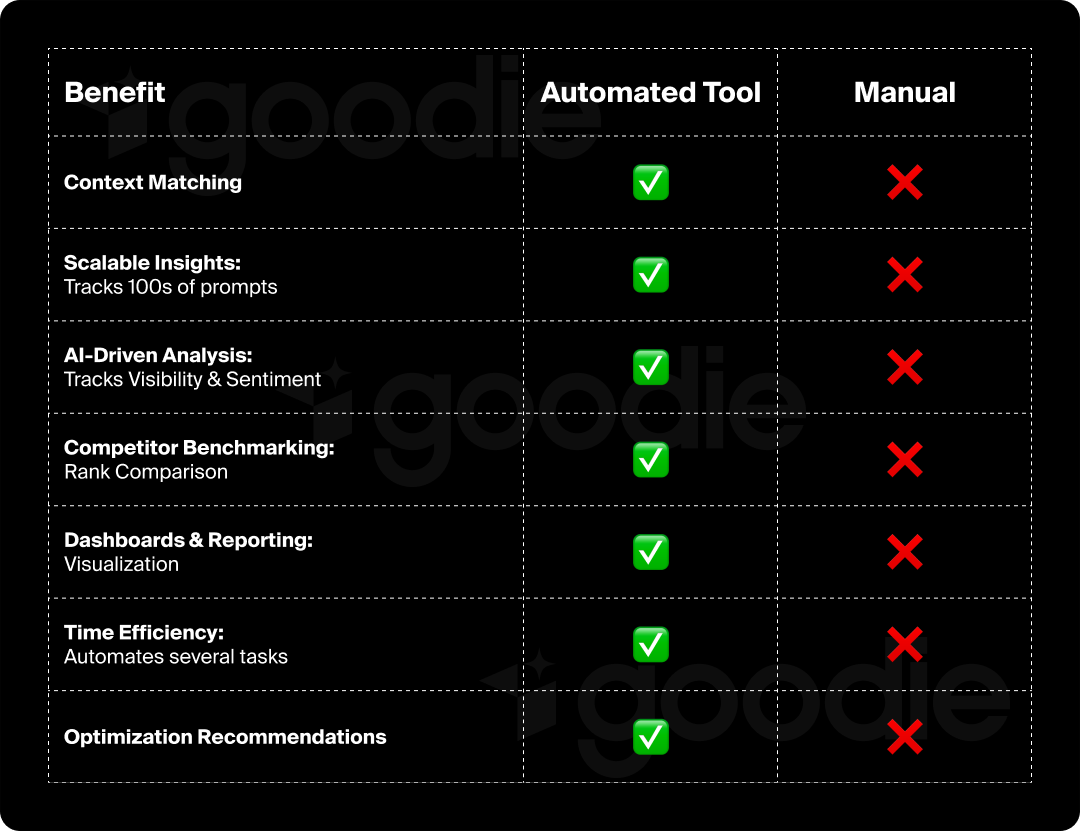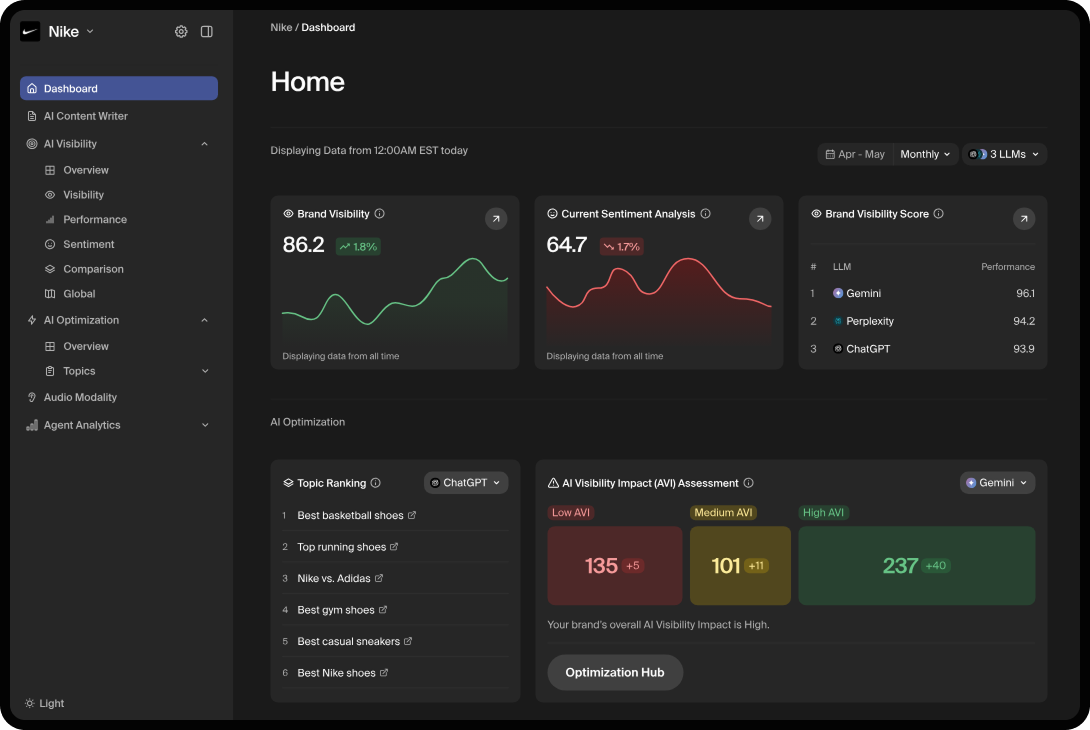Large language models (LLMs) like ChatGPT, Gemini, Claude, and Perplexity are quickly becoming mainstream. Forward-thinking brands are already optimizing their content for these platforms, racing to earn visibility in AI-generated answers.
While creating content for AEO is becoming more manageable, the bigger challenge lies in answering one crucial question: How do you measure the performance of your AEO efforts? Unlike traditional SEO, where rankings and traffic data are straightforward and consistent, AEO operates in a probabilistic space—the same question might yield different answers across different AI platforms, or even from the same model. These answers are often non-clickable, making performance tracking less direct and far more nuanced.
In this blog, we will break down exactly how to track and evaluate your AEO initiatives—what to measure, why it matters, and how to do it well.
AEO vs SEO Goals
With AEO, the goal isn’t necessarily to drive instant traffic or direct conversions. Instead, it’s about brand discovery and presence within AI-generated responses.
Why is this important? Because users often don’t go beyond the initial AI-generated answer. There’s no need to click a link, scroll through pages, or open multiple tabs. The AI delivers the entire response in one go. And yet, this interaction can significantly influence user behavior.
Even without a click, an AI-generated brand mention:
- Builds brand awareness
- Establishes credibility through AI’s “endorsed” answer
- Influences future searches, conversations, and buying decisions
Example: If your brand is listed in ChatGPT as a top tool in your industry, that mention may not lead to immediate traffic, but it increases the chances of users later searching for your brand, visiting your site, or converting through another channel.
Why don’t traditional SEO metrics apply to AEO? In SEO, rankings, impressions, and click-through rates provide a clear map of performance. These are based on deterministic systems—if your site ranks #1 today, chances are it still ranks #1 tomorrow, unless something significantly changes.
AEO doesn’t work like that. LLMs rely on probabilistic models, meaning:
- Responses vary based on the model’s training and external web sources
- Results aren’t fixed or consistent
- Answers may not include clickable links at all
That’s why AEO performance must be evaluated differently. You’re not tracking just traffic or rankings—you’re measuring presence, prominence, sentiment, and how those influence user behavior over time.

What AEO Performance Metrics Should You Track?
Here are 3 types of metrics that can help you evaluate AEO performance meaningfully:
1. Visibility Metrics (Primary metric)
Visibility is the foundation of AEO. These metrics help you assess how often and how prominently your brand is being included in AI-generated answers.
- Brand visibility score in ChatGPT, Gemini, Perplexity, etc: This reflects how frequently your brand is mentioned in AI responses relevant to your category. For example, if you ask Gemini, “What’s the best task management tool for teams?” and your brand is listed in the top three, that’s a win, even if it doesn’t lead to a click.
- Position or priority in LLM answers: Are you mentioned first, last, or somewhere in the middle? Higher placement often reflects stronger brand authority. Being listed in a response should be considered a win.
- Sentiment in brand mentions: LLMs learn from online content, including reviews (e.g., G2, Capterra), discussions (e.g., Reddit), and articles. Positive sentiment in these sources makes favorable mentions more likely in AI answers.
2. Engagement Metrics
Much of the brand discovery and evaluation happens within the AI interface itself, before a user ever visits your website. As a result, while your overall website traffic may decrease, traffic quality is likely to improve. Users who do click through have already done a fair amount of research through AI and are coming in more informed, curious, and ready to engage. This often translates to higher-quality sessions on your site.
To measure this effectively, focus on the following engagement metrics:
- Bounce rate: Are visitors sticking around or leaving right away?
- Average time on site: Are they exploring your content in depth?
- Pages per session: Are they engaging across multiple pages?
Engagement metrics tend to improve when your brand’s visibility and positive sentiment for the brand increase. For example, if Nike sees a rise in brand visibility for “best running shoes” across AI searches, they should also expect improved engagement on their running shoe product pages—across all traffic channels, including organic, direct, and paid.
3. Conversion Metrics
Although AEO primarily plays a role at the top of the funnel, it’s important to track its impact on downstream conversions. You may have noticed that many AI platforms—like ChatGPT—are now starting to appear in your website analytics as referral sources, often tagged with UTM parameters such as utm_source=chatgpt.com. As traffic from these LLM-powered platforms grows, you may begin to see a lift in bottom-of-funnel metrics, including:
- Actions initiated (form submissions, demo requests, or product views)
- Actions completed (lead forms submitted, purchases made, or demos scheduled)
- Live chat engagements
- Product support inquiries
- Direct revenue generated

The Challenge of Measuring AEO: Rag Is a Strong Influencer of Performance
Retrieval-Augmented Generation (RAG) is a technique used by most leading LLMs to enhance the quality and relevance of their responses. RAG-enabled AI models pull in real-time information from the web to supplement their answers.
Because these models reference external sources dynamically, any changes in the availability, credibility, or ranking of your brand across these sources can directly influence the outcome of an AI-generated response, similar to how Google’s algorithm updates shift the weight given to certain websites over others.
RAG allows LLMs to:
- Actively retrieve live data from the internet at the time of the query
- Combine it with their existing training knowledge
- Generate fresh, contextually rich responses using high-authority sources
Example: Ask Perplexity, “What are the top CRM tools for nonprofits?” and it might reference current blog posts, software comparison sites, and industry articles to compile its answer. If your brand is mentioned frequently in those sources, it increases your chances of being included.
Manual vs. Automated AEO Performance Tracking
When it comes to tracking your brand’s presence in AI search, there are two primary approaches: manual audits and automated tools. Unlike the Google search ecosystem, where we have tools like Keyword Planner, SEMRush, or Ahrefs to help us with search performance over time, similar reporting metrics are still a black box for the AI search ecosystem.
1. Manual Tracking: Hands-On Learning
Manual tracking typically involves running periodic queries across AI platforms like ChatGPT or Gemini to observe how and where your brand appears. This includes:
- Asking the same set of queries each week to check for consistency
- Noting any changes in phrasing, ranking, or brand mentions
- Reviewing the sentiment and context in which your brand is mentioned
Example: Maintain a simple spreadsheet tracking whether your brand shows up for queries like “best CRM for small businesses” or “top productivity tools for remote teams” every week across key AI search platforms.
While manual audits can be time-consuming, they offer significant value in today’s rapidly evolving AI landscape. These hands-on checks provide deeper insight into how different models interpret and represent your brand—nuances that automated tools may still miss. Though not easily scalable, manual analysis remains a powerful complement to automation and should be part of your routine, even if you already use other tracking tools.
2. Automated Tracking: Scalable & Consistent Monitoring
As the space matures, tools like Goodie AI have emerged to help brands monitor their AI search performance at scale. These platforms offer features such as:
- Brand visibility scores across ChatGPT, Gemini, Perplexity, and others
- Sentiment and positioning analysis
- Competitor benchmarking
- Topic-level reporting tied to your business objectives
- Optimization suggestions to improve inclusion and prominence
Because AEO is about visibility rather than traffic, these tools focus on discoverability metrics—measuring how often, and how favorably, you appear in AI-generated answers.

Goodie in Action: AEO Power Tool for Modern Brands
Goodie AI is a leading platform built specifically for AEO tracking and optimization. It offers a full suite of features to support both measurement and improvement:
- Real-time tracking of brand mentions across AI search engines
- Sentiment analysis across LLMs like ChatGPT, Gemini, Claude, Perplexity, and Deepseek
- Dual optimization strategies for both AI and traditional SEO
- AI-driven content recommendations to close visibility gaps
- Traffic and conversion attribution from AI interactions
💡 Why it matters: In a probabilistic AI environment where exposure = influence, tools like Goodie AI helps you track what matters—and take action to stay ahead.

As AI-driven search continues to evolve, the brands that adapt early—and measure smartly—will lead the way. Traditional SEO metrics no longer tell the whole story. AEO demands new tools, new KPIs, and a new mindset.
Your brand doesn’t need to “rank”—it needs to be recognized, recommended, and remembered. Tracking visibility, sentiment, and brand presence across LLMs is no longer a “nice to have”—it’s a competitive necessity.







